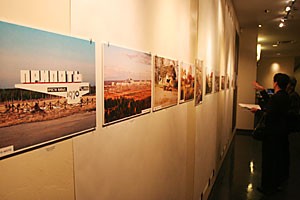It has been 20 years since the explosion of the No. 4 reactor at the Chernobyl Nuclear Power Plant in the Ukraine, still regarded as the worst accident in the history of nuclear power.
Photographs taken on the days immediately following the disaster are now displayed in “”Forbidden: The Legacy of Chernobyl, 1986 to 2006,”” an exhibition in the Student Union Memorial Center Union Gallery.
“”Many of the students at the university weren’t even born when this happened, so it will be good for them to see what can happen if you’re careless with the environment,”” said Zenovia Kunasz, a Ukrainian who has been in America since she was 8 years old. Her husband, Ihor Kunasz, is a geology professor at UA and is responsible for bringing this exhibition to the university.
Reproductions of original photographs taken during the Soviet Union era are pasted onto large paper frames that have scientific notations and formulas scribbled furiously on them.
The entire representation of frame and photograph is hung on the wall with strips of thick black tape. Some frames that should hold photographs contain blank black paper, representing the lack of information about the disastrous event.
“”It’s very somber. It awakens your sense of fear about people who take life for granted,”” Zenovia said. “”We have to be aware of being good to other human beings. We can’t take life for granted. It’s too precious.””
A simple picture of the site of the V.I. Lenin Memorial Chernobyl Nuclear Power Station, although slightly blurry and of poor quality, takes on an iconic quality when combined with the knowledge of what occurred there in 1986. Many Chernobyl workers were inexperienced and did not follow procedural rules while they tried to shut down the reactor and start it up again as part of an experiment to test how the reactor would perform if the power went out. Due to the hastiness of their work, the experiment did not go according to plan and caused an explosion and graphite fire that took firemen a week to control.
Many of the photographs depict the men drafted to take care of cleaning up the mess, also known as the “”liquidators.”” Photographs show them working in nothing more than jumpsuits and face masks.
“”People were not told about what had happened,”” said Ihor Kunasz. “”Doctors told people that everything was fine. The worst part was the impact on the people. Putting a mask on your face doesn’t protect against radiation.””
The exhibit also features photographs of the abandoned area of Chernobyl today. The photographs show an almost completely vacant rural town that hauntingly looks more dead than alive. Before the explosion, there were 14,000 people living in the area, while more than 336,000 people were evacuated and resettled due to the event.
All of the liquidators have died or are dying due to radiation, and many people who were exposed to the radiation, which spread throughout the entire northern hemisphere, are still dealing with the effects of the radiation.
“”My friends and my colleagues had problems with children,”” said Nina Tritenichenko, who was 21 and living in Chernobyl when the explosion took place. “”They had miscarriages.””
Tritenchenko has never experienced health problems herself, but her children have.
“”My first child was born sick and died one day after he was born,”” she said. “”My second child is 16 and living in an institution. He is mentally retarded. My third child, who is almost 13 years old, is normal and healthy.””
The photographs in this exhibit allow viewers to look into the past and to see the days following the Chernobyl meltdown. Museumgoers can walk away with a sense of the fragility of life and realize the risks of being uninformed about nuclear power and the disasters that occur when human lives are on the bottom of a government’s list of priorities.
The exhibition can be viewed through Dec. 10 at the Union Gallery, which is open Monday through Friday from 10 a.m. to 5 p.m.









